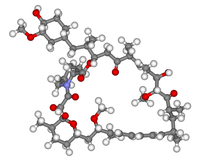
Photo from wikipedia
PI3Kδ inhibitors have been approved for B-cell malignancies like CLL, small lymphocytic lymphoma, and so forth. However, currently available PI3Kδ inhibitors are nonoptimal, showing weakness against at least one of… Click to show full abstract
PI3Kδ inhibitors have been approved for B-cell malignancies like CLL, small lymphocytic lymphoma, and so forth. However, currently available PI3Kδ inhibitors are nonoptimal, showing weakness against at least one of the several important properties: potency, isoform selectivity, and/or pharmacokinetic profile. To come up with a PI3Kδ inhibitor that overcomes all these deficiencies, a pharmacophoric expansion strategy was employed. Herein, we describe a systematic transformation of a "three-blade propeller" shaped lead, 2,3-disubstituted quinolizinone 11, through a 1,2-disubstituted quinolizinone 20 to a novel "four-blade propeller" shaped 1,2,3-trisubstituted quinolizinone 34. Compound 34 has excellent potency, isoform selectivity, metabolic stability across species, and exhibited a favorable pharmacokinetic profile. Compound 34 also demonstrated a differentiated efficacy profile in human germinal center B and activated B cell-DLBCL cell lines and xenograft models. Compound 34 qualifies for further evaluation as a candidate for monotherapy or in combination with other targeted agents in DLBCLs and other forms of iNHL.
Journal Title: Journal of medicinal chemistry
Year Published: 2020
Link to full text (if available)
Share on Social Media: Sign Up to like & get
recommendations!